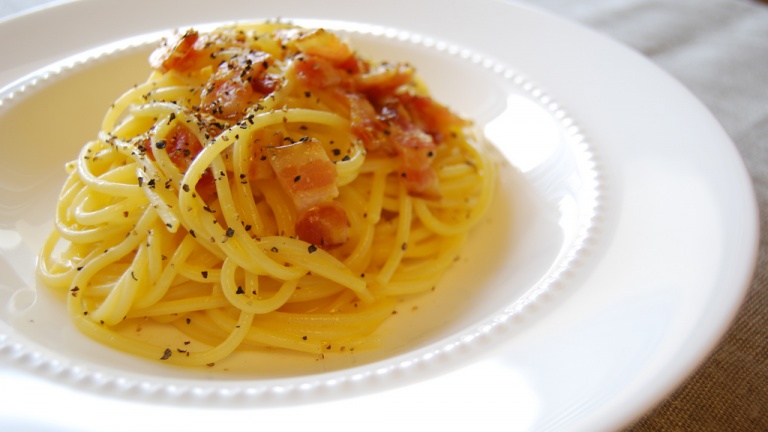Pasta alla carbonara: history and recipe
Welcome to the first article of a serie on the italian cousine. In this article I want to talk about one of the most known recepie: pasta alla carbonara.

HISTORY:
Pasta alla carbonara is a typical recipe of Rome and its region whose origin dates back to not too many years ago and is, today, still unclear: it is clear that it is a recipe that is replicated everywhere and often with aberrations that they upset it completely. We try to reconstruct the history of pasta alla carbonara and its origins and then get to the original recipe of pasta alla carbonara romana.
According to some, the carbonara arrived in Rome and Lazio after the liberation of Rome in 1944 when the Americans introduced bacon and freeze-dried eggs into Italy: an explanation that does not convince too much since the primary element of this recipe is the pork cheeck and not bacon. In fact, however, if we analyze the issue well, we must consider that the American origin of this dish would also explain the presence of cream and butter in some versions of the carbonara: the soldiers, according to some reconstructions, brought with them condensed milk with which "lengthened" the sauce of the pasta to make it more creamy.
Another theory attributes the dish to the area of the Neapolitan, considering the presence of a fairly similar dish in the text theoretical-practical cuisine of Ippolito Cavalcanti and the presence, in Neapolitan cuisine, of dishes that are seasoned using the same identical ingredients.
Another very accredited theory claims instead that carbonara derives directly from the cheese and ova from Lazio and Abruzzo and that it was born thanks to the woodcutters who brought eggs, pecorino and pork cheeck in their bags, and prepared pasta during their migrations; the pepper was not added posthumously but was used to preserve the pork cheek and then ended in the dish during cooking, determining its dark color. In support of this thesis also the word "carbonara" which closely resembles "carbonada", the Abruzzese word for pancetta.
The origin of the carbonara is therefore quite unknown and it is also for this reason that its fame, probably, has grown over time.
The most used pasta shapes for carbonara pasta are the penne and especially the spaghetti that keep the cooking and blend well with the ingredients. Although many prepare the carbonara pasta with cream, the recipe does not include either this ingredient or onion, garlic or parsley without considering chicken and meat that is not guanciale. An excellent recipe of carbonara pasta is found in the manual by Livio Jannattoni The Roman and Lazio cuisine where the author confirms that for the pasta carbonara it is not necessary to use for strength cheek but bacon is good.
According to one of the most accredited theories, the name of carbonara is linked to the presence of ground black pepper which in the traditional recipe should blacken the dough to the point of making it appear covered with coal dust?
Do you know that only for the amatriciana pasta should you use pork cheek and never bacon? For the carbonara you can use both paying attention to brown the pancetta in a little oil if you choose to use this ingredient instead of the pillow that instead requires no oil.
INGREDIENTS:
For 4 people
- 13 oz of spaghetti
- 150 g of pork cheek
- 4 egg yolks
- 100 g of Pecorino cheese
- Salt and Pepper To Taste.
PREPARATION
Cook the spaghetti in boiling salted water.
Meanwhile, cut the pork cheek into strips and fry in a pan without adding oil.
Simultaneously beat the egg yolks with the pecorino cheese in a bowl: add two tablespoons of spaghetti cooking water and a mince of black pepper.
Drain the spaghetti.
Pour the spaghetti into the pan with the bacon and mix well. Remove the pan from heat and add the beaten egg yolks: mix well and add a spoonful of cooking water for a creamy result.
Sprinkle with grated Pecorino cheese and a mince of black pepper.
Serve immediately.
thank you so much for sharing your knowledge and recipe for making this amazing pasta